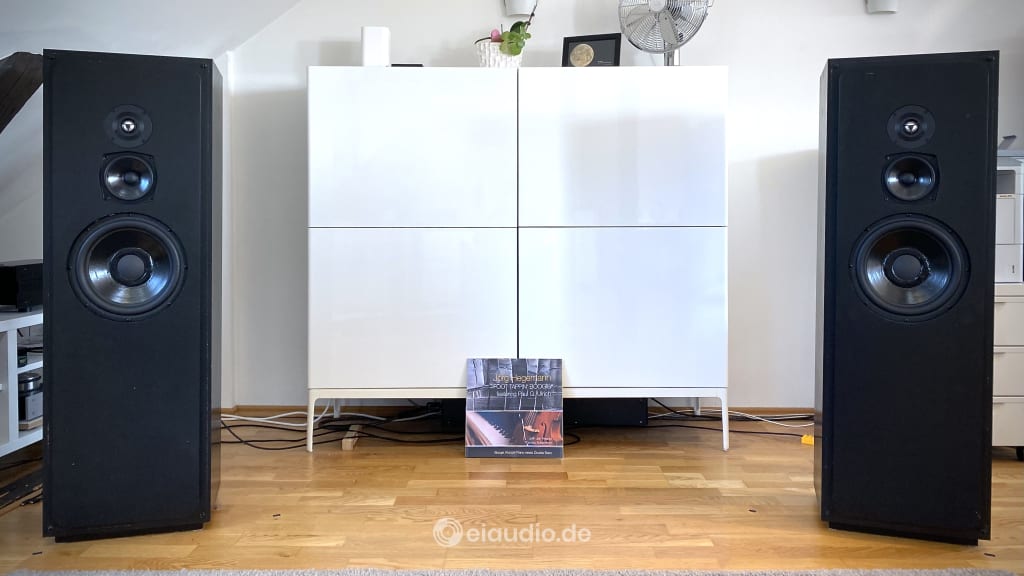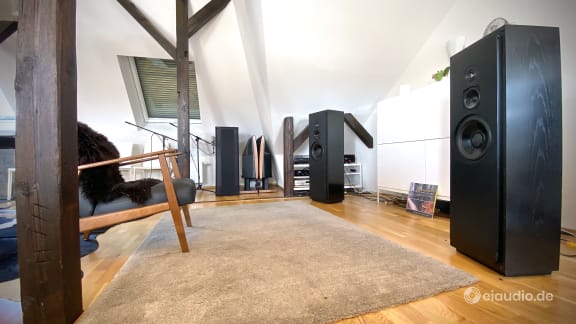Snell Acoustics Type C IV
Published: 30/08/2021
Manufacturing date: 1983
Author: Karsten Hein
Category: Gear & Review
Tag(s): Loudspeakers
I first heard Peter Snell’s C IV loudspeakers perform in the dining room of a Wiesbaden townhouse and was instantly taken in by the realism with which the club atmosphere of Christian McBride’s album “Live at the Village Vanguard” was recreated. The spacious room boasted a ceiling height of nearly 5 meters and was sparsely furnished, with a massive dining table and chairs dominating its centre. The speakers were positioned far away from the walls, approximately two meters from the front wall and 1.5 meters from each side. They were driven with a Dynaco ST70 tube amplifier. Everything in their sound—stage depth, width, resonances—suggested that we were were listening to the actual event, rather than a recording of it. I could literally smell the scent of stale beer and cold cigarettes.
I learned two things that day: The ultimate goal of HiFi does not lie in deeper bass or higher treble, nor in clearer sound or greater dynamics, but rather in the sum of all parts to recreate the authentic event. And second: The room and positioning of the loudspeakers play a major role in making the illusion of a performance become reality. And once we have heard it, once that vision has been installed in our minds, it is very difficult to listen to anything less. Most newbies in HiFi have been taught to dissect music rather than achieve homogeneity. Data, rather than feeling, is the message conveyed by the audio press. Hence, new arrivals to the HiFi scene will look for the right specs on their gear rather than make sure to get the right sound. One can spend a lifetime in HiFi and still have very little clue of what it is actually about.
It is probably fair to say that the Dynaco ST70 tube amplifier played a major role in the recreation of the authentic event. Neither the wattage of this amplifier nor its channel separation, damping factor, signal to noise ratio, etc. indicate the amount of realism this amplifier is capable of. Hence, it is no surprise that, in a world run on facts and figures, it took me close to 50 years and some repeated nudging from fellow audiophiles to finally be able to listen to and comprehend the merits of a performance that deserves the term ‘high fidelity’, i.e. as close to the original as possible. That day, “Live at the Village Vanguard” really felt live. It prompted me to purchase the vinyl record and write a review on it. And it also got me interested in the C IV speakers.
Snell Acoustics was founded in Haverhill Massachusetts in 1976, and the company soon made a name for itself selling audiophile loudspeakers at reasonable prices. After sales service was exceptional, as Peter Snell was a perfectionist and made sure that each of his speakers measured to spec with deviations below 0.5dB per chassis. The same was true of all the replacement parts the company sent out, often many years after the original date of purchase. Audiophiles constitute a small and intimate circle, and especially bang for buck producers often benefit from word of mouth and manage to build up longstanding relations with their thankful customers.
Launched in 1983, the Type C series was among the last loudspeakers actually designed by the company founder himself. Peter Snell died from a heart attack in his factory in the following year. Despite the absence of its original owner, the company continued to evolve and, in 1990, joined forces with Lucasfilm to design its first line of THX loudspeakers. In 2003, the by then renowned Joe D'Appolito joined Snell as chief engineer. In 2005, Snell and Boston Acoustics were purchased by D&M Holdings—which also owned Denon, Marantz, and McIntosh—and Snell would continue to build loudspeakers until 2010. Throughout its existence, the loudspeaker manufacturer stood for great customer service, tonally accurate acoustic designs, and great attention to technical detail.
The Type C IV series are said to have been heavily influenced by the methods and measuring philosophies of the National Research Council (NRC) based in Ottawa, Canada. Typical characteristics of speakers developed in conjunction with the NRC are steep crossover slopes, wide dispersion, smooth off-axis response, and special focus on a speaker’s interaction with natural listening rooms. The C IV has fourth-order crossover slopes, a very flat frequency response that varies very little off-axis. A rear tweeter was added to compensate for the front tweeter’s increasingly narrow beam at high frequencies. It can be turned off with a toggle switch to accommodate smaller listening rooms. The C IV boasts what the company called a “Zero Diffraction” grille. The idea was to wrap the removable grille’s wooden frame around the speaker front in order to minimise the distance between cloth and divers and decrease diffraction.
The additional tweeter at the rear comes in at around 6kHz with a first-order slope. It contributes to the front tweeter’s energy and helps to create a stage impression that is both wide and deep. Depending on the distance to and material of the front wall, the additional tweeter can cause some harshness. To turn the speakers to the room, the C IV’s front tweeter can be regulated. Alternatively, a switch at the back allows us to turn the rear tweeter off completely. To make full use of the C IV’s abilities, it should be placed in a large room with approximately 1,20m distance to the front wall and some distance to the sides. Set up in this way, the rear tweeter supports the illusion of the music breaking free from the source with the speakers themselves becoming invisible. Toe-in helps to correct the stage impression. I must confess that, given the peculiar shape of our room, I did find it difficult to get the stage as perfect as I had heard the speakers capable of in the Wiesbaden townhouse, but I can say that I came quite close.
With the rear tweeter switched on and the right distance to the walls, the C IV created a broad and open stage. And with the grille cloth in place, they produced a pleasantly soft treble, even at short range. For those sitting at a distance of 3 meters or more from the speakers, there is some treble fall-off, and listening without the cloth might be preferable. Despite Snell’s “Zero Diffraction” promise, the difference between open and closed operation is quite audible. In our listening room, the C IV produced an open and spacious top end and a natural and fully integrated bass. The speakers sounded tonally accurate and presented the music nice and full with great timbre on the lower piano keys. There was sufficient presence of the higher piano keys as well, however, in direct comparison they were missing some of the attack of our electrostatic speakers or even our more recent Tannoys. Male vocals sounded natural with a slight tendency of thinning when the rear tweeter was switched on (e.g. Nick Cave). Female vocals showed much of the same effect (Nora Jones, Come Away with Me), especially when playing music from digital sources.
Also see: Snell Acoustics Type C IV Audio Demo
The Snells showed convincing overall dynamics and, due to their large bass driver and ported design, they were capable of swelling in volume quickly. When set at 75dB volume, my wife reported that she felt quite overwhelmed by the music and that she would have preferred to sit farther away from the speakers. It was the first time that I had heard her comment on loudspeaker in this way. I would think that the effect was caused by a combination of the sonic impression and the speaker’s design. Standing far into the room, nearly 120cm tall and 40cm wide, with their black grille cloth in place, the physical image alone was quite intense, indeed.
Specifications:
- Type: Four-driver dynamic loudspeaker
- Drivers: 10" woofer; 5” midrange; 1” front tweeter; ¾” rear tweeter
- Crossover frequencies: 275Hz; 2.7kHz (@24dB/octave)
- Nominal impedance: 8 Ohms
- Sensitivity: 88.5dB
- Dimensions: 37cm (W); 117cm (H); 30cm (D)
- Weight: 39kg
- Year: 1983-1991





